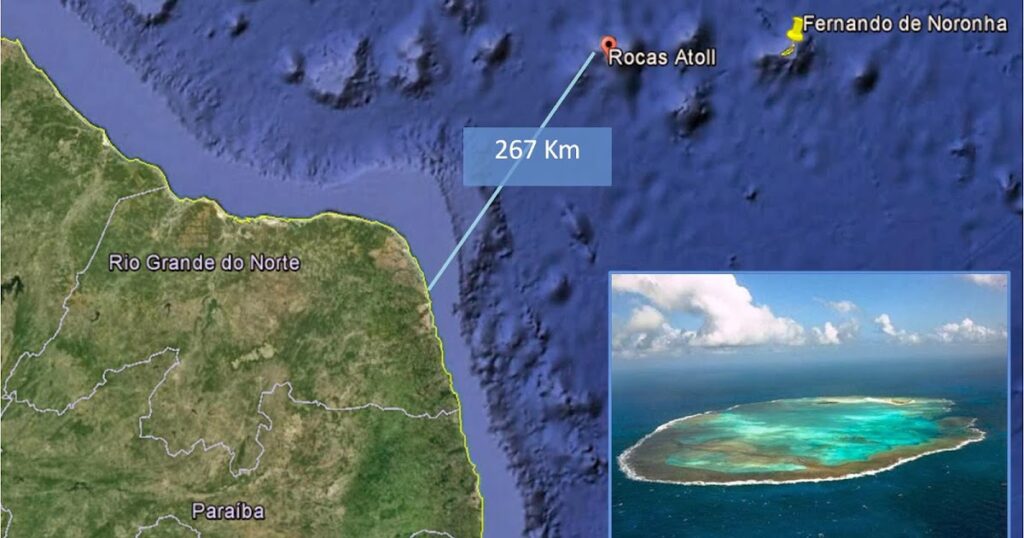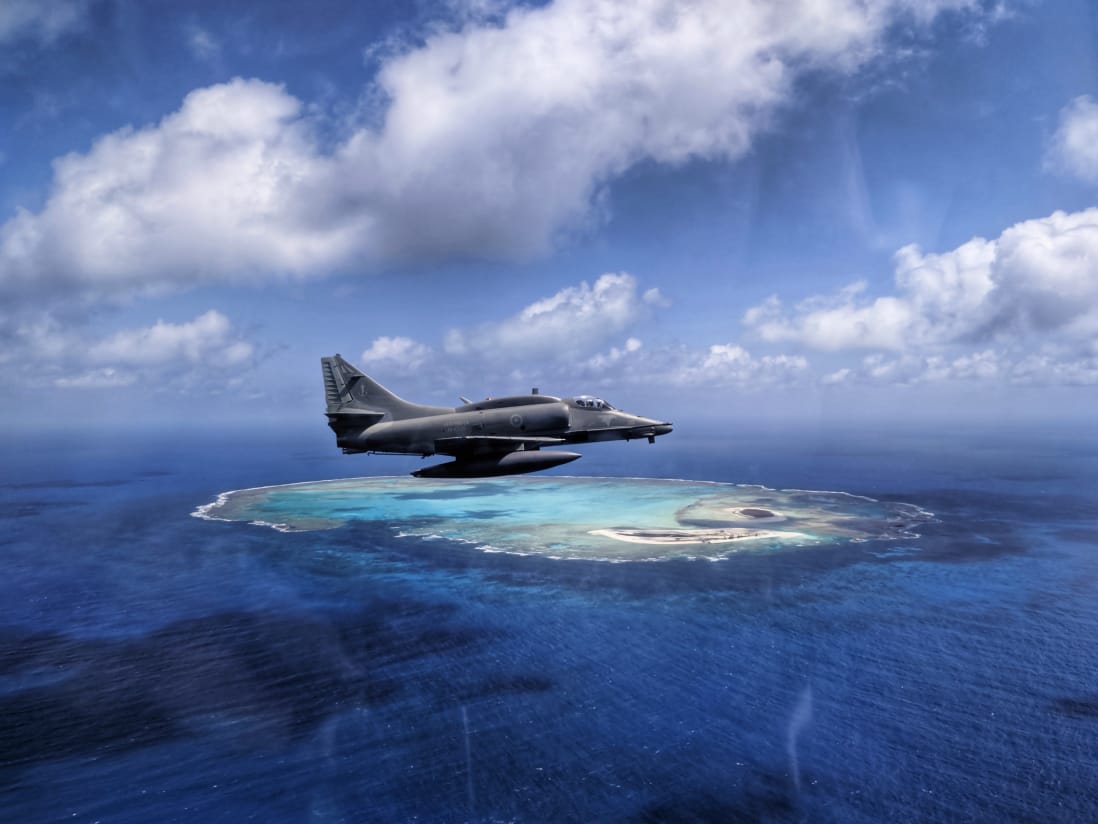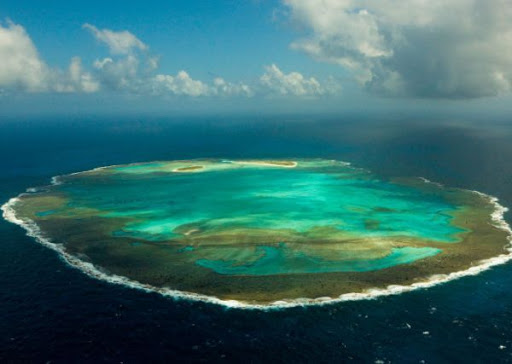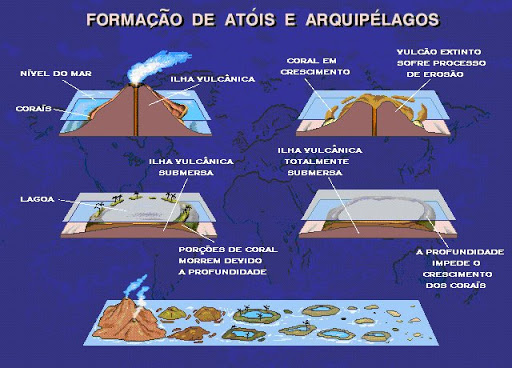
Atol das Rocas is the only atoll in the western South Atlantic.
Located about 145 kilometres west of the Fernando de Noronha archipelago and about 260 kilometres northeast of the city of Natal in Rio Grande do Norte, Atol das Rocas is the only atoll in the western South Atlantic Ocean.
Atol das Rocas, one of the Brazilian Islands, is of great ecological importance because of its high biological productivity and because it is an important shelter, feeding and breeding area for several animal species.
Atol das Rocas became Brazil’s first Marine Biological Reserve on 5 June 1979.
The inclusion of the Atol das Rocas Biological Reserve in the World Heritage List is based on the fact that they represent oceanic island ecosystems with highly productive waters that provide food for tuna, sharks, whales and sea turtles migrating to the eastern Atlantic coast of Africa.
They are true oases of marine life in a relatively barren ocean, contributing to the reproduction, dispersal and colonisation of marine organisms in the tropical South Atlantic.
The islands are made up of limestone sediments, fish skeletons, corals, birds, shell fragments and crustaceans; they have an equatorial climate and dense herbaceous vegetation.
Flying over the reserve, it’s impossible not to see the clouds of birds, around 150,000 of 29 different species. On land, the diversity is even more remarkable: there are breeding species, foragers, migrants, sporadic visitors and others.
Atol das Rocas is an important study site for the Tamar Project because it is a breeding site for sea turtles, especially the green turtle.
The vegetation is dense, typically herbaceous and resistant to salinity, excessive light and the action of the tides. The species have halophytic characteristics. On Ilha do Farol there are two casuarina trees that provide shelter for seabirds.
The atoll is considered one of the most important seabird breeding sites in Brazil and is home to a wide variety of birds, including the masked booby, brown booby, red-footed booby, black-crowned frigatebird, brown scalloped booby and black scalloped booby.

Atol das Rocas consists of two islands
The two islands are about 3 metres above high tide and can be seen at a distance of about 10 nautical miles, depending on the direction of approach to Atol das Rocas.
1. Farol Island
The 34,637 square metre Ilha do Farol was known by the French and English as Sable or Sand. Atol das Rocas is situated on an underwater mountain, part of the Fernando de Noronha mountain range, which is of volcanic origin.
Its current name is due to the construction of the first lighthouse in 1881, which was abandoned because the tower didn’t meet the needs of the location. The lighthouse is still active and was inaugurated in 1967.
It covers an area of about 34,600 square metres, is 1 kilometre long and 400 metres wide, and was known to the French and English as Sable or Sand.
It owes its current name to the construction of the first lighthouse on the island in 1881, which was abandoned because the tower didn’t meet the needs of the site. The lighthouse that still stands on the island was inaugurated in 1967.
2. Cemetery Island
Cemetery Island, which covers 31,513 square metres, was also called Grass or Capim.
It was given this name because of the many shipwrecks that occurred on the island and the deaths of lighthouse keepers and their families.
Little known to the Brazilian population, its distance from the mainland can be considered the main factor that makes it difficult for visitors to access, but it is also seen as a positive aspect, as it is a protected area under environmental legislation.
Only a privileged few have been to Atol das Rocas, including fishermen, sailors and researchers.
Covering some 31,500 square metres, 600 metres long and 150 metres wide, it was called Grass or Capim.
Videos about Atol das Rocas and the formation of an atoll


Reserva Biológica Marinha do Atol das Rocas - EP106:40

Reserva Biológica Marinha do Atol das Rocas - EP206:21

Reportagem sobre o Atol das Rocas04:40

Reserva Biológica Atol das Rocas01:00

Formação de um atol02:05
ORIGIN OF ATOL DAS ROCAS
Atol das Rocas was formed in the same rift zone perpendicular to the Atlantic Dorsal chain that formed the Fernando de Noronha archipelago (Fernando de Noronha Rift Zone).
Like the archipelago, Atol das Rocas is the top of an immense volcanic edifice whose base is lost in the Atlantic abyss.
The difference between these two formations lies in their volcanic heights, since while Noronha rises up to 323 metres above sea level, Rocas rises at sea level (more susceptible to wave action).

Over time, the action of the waves has reduced the entire ridge to a few metres – two or three – below the sea surface. The formation of this near-surface substrate, due to the availability of light and nutrients, allowed colonies of calcareous algae and corals to form.
The development of these colonies on the edges of the submerged volcanic formations gave rise to circular reefs (due to the summit of the submarine volcano), with the presence of lagoons inside. This reef formation is called an atoll.
Atol das Rocas has the shape of a semicircular ellipse with an internal surface area of 5.5 m2. Its east-west axis is about 3.7 kilometres and its north-south axis is about 2.5 kilometres.
Although the atoll is small and lacks a deep lagoon, a fact that has been used to argue that Rocas is not a true atoll, its current morphology has several characteristics found in atolls around the world.
Characteristics of atolls
- The presence of a shallow lagoon and sandy islands leeward of the reef, characteristic of Caribbean atolls;
- The presence of a ridge of coralline algae at the edge of the reef, characteristic of Indo-Pacific atolls;
- the greater extent of the reef ring on the windward side of the atoll.
In the geological fracture that includes Fernando de Noronha and Atol das Rocas, there are several other submerged mountains, aligned on the latitude of Fortaleza, on the coast of Ceará.
Their peaks are between 20 and 30 metres below the surface of the sea.
Over the last 100,000 years, during the various glaciations, the sea has been about 100 metres lower and these peaks have formed a series of islands, more or less close together.
This allowed species to migrate for thousands of years from adjacent coastal areas to colonise distant areas such as the Fernando de Noronha archipelago and Atol das Rocas.
At the end of the Ice Age, sea levels rose again and almost all the islands were submerged. The species that remained on the submerged lands of the remaining oceanic formations (Noronha and Rocas) survived.
The atoll of Rocas, with a lower altitude and less favourable conditions than Fernando de Noronha, ensured less diversity and less noble species of flora and fauna.
A PAST OF LEGENDS AND SHIPS ON ATOL DAS ROCAS
The history of mankind on Atol das Rocas is one of legends, shipwrecks and many deaths. There is no clear record of who discovered the atoll, perhaps because the discoverer was also shipwrecked.
Some authors attribute the discovery to Gonçalo Coelho in 1503, on the same expedition that discovered Fernando de Noronha.
What is certain is that navigators of the 16th century were already afraid of its shallow reefs. Despite this widespread fear, which continued well into the era of motor boats and ships, it was not until the last century, in 1957, during the International Geophysical Year, that the exact location and coordinates of Atol das Rocas were recorded on nautical charts.
During the 16th, 17th and 18th centuries, the atoll kept the eyes of hundreds of captains open, day and night, as they passed between the Brazilian coast and the Fernando de Noronha archipelago.
Between 1803 and 1890, history recorded five major shipwrecks on Atol das Rocas. Four of them occurred in October and one in March (the period when the currents are most active).
The most famous shipwreck of this period was the Duncan Dubar, an English ship with over 100 crew and passengers on board, most of them emigrants from Plymouth, England, bound for Sydney, Australia.
The Duncan Dubar ran into the equatorial current while drifting in a calm. On the night of 7 October 1865, she crashed into the reefs of the atoll with her rudder destroyed and a huge hole in her hull.
Men, women and children did not leave the ship until the next morning, when the fury of the waves had already destroyed part of the side.
Crammed into the sloops, they miraculously crossed the surf unharmed and landed on the sand, where they remained for 10 days.
The rescue was only possible thanks to the heroic gesture of Commander Swanson, who left the atoll in a scaler, accompanied by six sailors, and headed for the Brazilian coast.
It took them five days to reach the coast of Pernambuco, where they were lucky enough to meet another British ship, the Oneida. At the risk of sinking due to overcrowding, the Oneida took all the castaways on board, ruined but alive, and made the long journey back to England with them without further incident.
The installation of the first lighthouse in 1883 reduced sailors’ fears, but gave wings to the death legends that grew out of the loneliness of the lighthouse keepers. One of the tongues of sand was named Cemetery Island because lighthouse keepers, their families and shipwreck victims were buried there.
The lack of fresh water sources meant that the lighthouse keepers’ lives depended precariously on supplies from the mainland or the hope of rain to fill the cisterns.
At the turn of the century, the wife and children of a lighthouse keeper died of thirst because one of the children had left the cistern tap running until it ran dry.
In desperation, the lighthouse keeper set fire to the house to see if he could attract a ship, but help arrived too late and only he survived.
Legend has it that the souls of his wife and children are trapped on the island of their misfortune, haunting visitors at night and begging for water.
Lighthouses – first traditional and now automatic – have reduced, but not eliminated, shipwrecks.
Even today, reefs continue to steal the attention of helmsmen and bring dreams of sailing to an abrupt end.
On 26 June 1979, the Mon Ami, a 13-metre, two-masted sailing vessel, sank.
Its crew, three South Africans and one Australian, spent 21 days in an improvised camp on the atoll, sharing their boat’s provisions and rainwater with rats, mice, scorpions and cockroaches.
Despite persistent radio distress signals, lifeboats thrown overboard with pleas for help, and the beckoning of a plane on the eighth day, the Mon Ami castaways were not rescued until 16 July by a Brazilian navy corvette, after another plane had passed and a Norwegian tanker was visible on the horizon.
CLIMATE AT ATOL DAS ROCAS
The climate of Atol das Rocas is tropical oceanic, tempered by trade winds from the east and southeast that blow all year round.
Winds between 6 and 10 m/s prevail throughout the year, but in winter winds between 11 and 15 m/s are common.
Wind speeds in excess of 20 metres per second are more common in summer. The average annual atmospheric temperature is 25°C, with February being the hottest month of the year and August the coldest.
Rainfall is unevenly distributed throughout the year. In general, there is less rainfall in April and more in August. The waters around Atol das Rocas belong to the South Equatorial Current, which originates off the coast of Africa from the Benguela Current.
The average water temperature on the outside of the atoll is 27°C, but in the pools on the inside of the reef, the water can reach 39°C.
BIOLOGICAL COMMUNITIES PRESENT ON ROCAS ATOLL
1. Characterisation of the flora of Atol das Rocas
The vegetation is typically herbaceous, resistant to salinity, excessive light and the constant action of the tides.
Some species have their own peculiarities (their branches are directed towards the sea and their structures are resistant to being buried, growing continuously and forming a tangle).
The species found on the atoll belong to the Amaranthaceae, Aizoaceae, Portulacaceae, Cyperaceae, Gramineae and Amaryllidaceae families. There are two dead casuarina trees on Ilha do Farol, which provide a base for seabirds.
There are only a few large coconut trees, introduced before the reserve was created. There are also a few other plant species introduced by fishermen and sailors.
At Atol das Rocas, the reef surface is mainly covered by macroalgae (about 110 species of macroalgae have been identified and catalogued, two of which are new to Brazil) and an association of encrusting calcareous algae and vermetid snails.
Massive corals such as Siderastrea stellata, Montastrea cavernosa and Porites occur only in areas protected from wave energy, mainly in lagoons, tide pools and in some recesses of the reef front.
Although it is argued that coralline algae generally have a limited role in reef building due to ecological and environmental constraints and their low vertical growth rate, Rocas is an example of these organisms being able to grow vertically at relatively high rates.
Seven coral species of the order Scleractinia have also been identified on the atoll. A total of 38 sponge species have been described, including Spirastrella coccinea, Chondrilla nucula and Topsentia ophiraphidites.
Research suggests that the low level of species competition and herbivory at the site may be ecological factors that have favoured the intense growth of encrusting coralline algae in Rocas, as well as high hydrodynamic energy.
There is also a great diversity of crustaceans, represented by 11 families and 18 species, especially the land crab, Gecarcinus lagostoma, and the aratu, Grapsus grapsus, species that only occur on oceanic islands.
2. FISH
The waters surrounding the atoll are home to a large number of commercially exploited fish species, including yellowfin tuna, several species of grouper, snapper, grouper and whiting.
Researchers have catalogued some 147 species of fish in the reserve. Two of these are endemic, meaning they only occur in Atol das Rocas and Fernando de Noronha: the Rocas damsel, Stegastes rocasensis, and the Thalassoma noronhanum.
Although the biomass of herbivorous fish on Rocas is comparable to reefs elsewhere in Brazil or the Caribbean, only one genus of coral grazer has been found on the atoll (genus Sparisoma).
Furthermore, the species of this genus have less powerful jaw muscles than the parrotfishes of the genus Scarus, which are the most powerful grazers in the reef ecosystem and do not occur in Rocas.
This difference in the structure of the Rocas fish community may also have contributed to the increased growth potential and preservation of encrusting coralline algae, as herbivory by parrotfish is one of the most important ecological controls on the development of coralline algae.
Atol das Rocas has the largest colony of tropical seabirds in Brazil (at least 150,000 birds belonging to 29 different species). Five species breed (nest) on the atoll, both on Farol Island and Cemitério Island.
They are: Masked Booby (Sula dactylatra), Brown Booby (Sula leucogaster), Black-browed Kinglet (Sterna fuscata), Brown Widow (Anous stolidus) and Black Widow (Anous minutus).
In addition to the nesting species, there are permanently migratory foragers, sporadic visitors and waders (who live in muddy and swampy areas).
In Fernando de Noronha, two species of permanent foraging seabirds can be observed throughout the year, using the coconut palms, dry bushes and ruins of Atol das Rocas as resting places and the surrounding areas to catch their prey: the Red-footed Booby (Sula sula) and the Frigatebird (Fregata magnifi cens).
To date, five species of oceanic migratory birds have been recorded in Atol das Rocas, three from the north and two from the south.
Sparrows (Passer domesticus) can be seen with a few individuals near the lighthouse, probably from boats that have visited the atoll, as well as sporadic herons (Bulbucus ibis), yellow-billed pintails (Phaethon lepturus), red-tailed godwits (Phaethon aethereus) and Palaearctic swallows (Glareola pratincola), and the marine species Sterna antillarum, probably from the Caribbean and the Gulf of Mexico.
The last group of birds recorded on the atoll, and one of the most spectacular for its peculiarities, are the waders, which come from both the northern hemisphere and the Old and New Worlds, such as the curlew (Tringa spp), the batuíra (Charadrius semipalmatus) and the fuselo (Limosa laponica).
3. SEA TURTLES
5 species of sea turtles are found in Brazil.
The area is also the second largest nesting site for the green turtle Chelonia mydas in Brazil, and a shelter and feeding area for the hawksbill turtle Eretmochelys imbricata.
The first agreement drawn up for the effective implementation of the Atol das Rocas Biodiversity Network was signed in 1990 between Ibama and the Pró-Tamar Foundation, with the essential support of Petrobras for the transport of the first shelters.
Tamar has been able to collect important data, not only on the reproductive biology of the green turtle, but also on the bioecology of juvenile green and hawksbill turtles, which inhabit the area full of seaweed beds and coral and sponge reefs, which are the main food sources for these species.
CONSERVATION STATUS AND MAIN THREATS TO THE ATOLL
As mentioned above, Atol das Rocas was declared a Marine Biological Reserve on 5 June 1979 and a World Heritage Site by the United Nations Educational, Scientific and Cultural Organisation (UNESCO) on 13 December 2001.
Biological reserves mainly protect wildlife and are theoretically closed to tourism and any kind of economic exploitation.
Theoretically, because it is very difficult to avoid the presence of fishing boats, ships and sailboats in the 36,000 hectares of protected area, including submerged lands and underwater limestone formations, as well as being some 260 kilometres from the nearest coast (Rio Grande do Norte) and 145 kilometres from Fernando de Noronha (the only inhabited island in the region).
Under current Brazilian legislation, to enter the atoll or dive in its waters, a permit must be obtained from the Brazilian Institute for the Environment and Renewable Natural Resources (Ibama). Until 1993, this requirement was simply ignored by the vast majority of sailors and the curious, as there was no enforcement.
In 1993, a permanent post was built (two prefabricated wooden houses next to the ruins of the old lighthouse) for the volunteer teams of the Ibama Fishing Watch.
The main concern of these teams is the increasing boldness of industrial fishermen in prohibited fishing waters, as well as the possible spillage of diesel and other pollutants, sometimes carried by currents from the high seas.
As on most oceanic islands, mice (Mus musculus), scorpions (Isometrus maculatus), cockroaches (Periplaneta americana) and other pests have been accidentally introduced to the atoll and have proliferated, according to reports in recent years from lighthouse keepers and some castaways.
These invasive organisms travel clandestinely on boats and ships, hidden in the supplies or cargo being transported.
So far, there is no evidence that these species directly affect eggs or birds, although they compete for space and could, in the future, jeopardise the ecological balance of the islands, whose ecosystems are always more fragile than those on the mainland due to their isolation and small size.
Atol das Rocas – Origin, biology, climate and shipwrecks
Northeast tourism and travel guide
Publicações Relacionadas
Spinner Dolphins in Fernando de Noronha: A Guide
The island of Santa Catarina is part of the municipality of Florianópolis
Ponta do Boi Lighthouse in Ilhabela
The Marajó Archipelago
Surfing in Fernando de Noronha: Everything You Need to Know
Diving in the Fernando de Noronha Archipelago
Trindade and Martim Vaz: Discovering the Archipelago
Fernando de Noronha archipelago
Itamaracá Island: Your Ultimate Guide to Tropical Bliss in Brazil
Anchieta Island: History, Beaches, and Nature
How to get there, when to go and what to do in Fernando de Noronha?
Wreck of the Corvette Ipiranga in Fernando de Noronha
Fernando de Noronha Beaches: A Complete Guide
São Pedro and São Paulo Archipelago
Experience the Tropical Paradise of Ilha Grande in Rio de Janeiro
Brazil has oceanic and continental islands
History of Itaparica Island in the Baía de Todos os Santos
Alcatrazes Archipelago: Secrets of Evolution Revealed
This post is also on:
![]() Português
Português ![]() English
English ![]() Deutsch
Deutsch ![]() Español
Español ![]() Français
Français



















